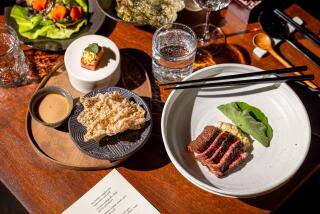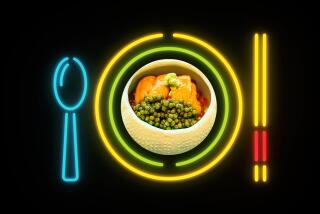DECOR : Setting Who, What, When and ‘Ware
- Share via
Were you born with a silver spoon in your mouth? Or would you be found below the salt? These expressions of high or low social status were derived from culinary traditions.
“Below the salt” goes back to the days when salt was very valuable and therefore reserved for the nobles who sat above the salt cellar. “Born with a silver spoon” referred to the boxed sets containing a silver engraved knife, fork and spoon given a child at birth as a symbol of status. The child would take this personal set when he or she went away to school or on visits.
Historical tidbits such as these intrigue Maura Graber, director of the R.S.V.P. Institute of Etiquette in Ontario. She often gives lectures on table settings. She will present a seminar Thursday and Friday at R.S.V.P., a Tustin store specializing in table decor.
“I have a fascination for the unusual,” Graber said. “I started my business by giving children classes in etiquette, but as I was researching traditions, I became interested in antique flatware and the different utensils that have been used during the centuries.”
The “eating” fork was first used in the Middle Ages only for sweet, sticky foods, such as fruit in syrup. This type of fork, often accompanied by a spoon and sometimes a toothpick, was a personal possession rather than something provided by a host.
The actual practice of using a fork with a knife to eat meat was established in 16th century Italy and gradually spread north, reaching England in the early 17th century, although it wasn’t in widespread use until after the Restoration in 1660, Graber said.
“An Italian countess popularized eating utensils, but I’m not sure whether it was Catherine de Medici or not,” Graber said. “When royalty starts doing something, everyone starts. The knives, however, were made with blunt edges, so there would be no killings at the table during disagreements.”
The fork made then was simpler, stronger and larger than those made just for sweets. The first meat forks had two or three prongs, but a four-pronged type was developed before the end of the 17th century.
With the fashion of flatware and serving utensils came a plethora of patterns, styles and types of pieces.
“They kind of went nuts,” Graber said. “In Edwardian times, there could be as many as 31 different utensils used for a formal dinner.”
The English and the French were in a competition over who could come up with the most utensils, then the French dropped out of the race. The English were more interested in the utensils than the food, she said.
The French then developed “rests” to place utensils on between courses. This reduced the number of utensils needed for all the courses and the need to do as much linen laundry.
“I like the investigative work,” Graber said. “It’s interesting to find out the history.”
She has found that in napkin-ring etiquette, it’s proper in the United States to put the napkin back in the ring, but in France, this is rude because it presumes you are a permanent guest.
In her silver collection is an olive spoon from the Victorian times that is coated with vermeil, a thin layer of gold, so it doesn’t corrode the silver.
“If you have any utensil coated with vermeil, it’s a giveaway that it’s for something salty,” she said, such as olives. Husband Cliff’s family business is Graber Olives, and the couple and their two children live in the Graber Olive House, which is nearly 100 years old.
Other vintage utensils she owns are butter forks used for picking up little balls of butter, a sardine fork with a salmon design and a sucket fork with a spoon on one end and a two-pronged fork on the other.
“This was used for ginger plums that were very popular during the Colonial times,” she said. “What you would do is spear the plum and eat it and then turn the sucket around and drink the syrup from the spoon side. It took about 100 years, but then someone decided to put the spoon and fork on the same end, so now we have pastry forks that combine both.”
Some of the utensils she has are very practical.
“One butter knife stands on its side in a butter dish rather than flopping over. These are very rare,” she said. Other oddities include a waffle server, grapefruit spoon with serrated edges, a berry-serving spoon and a marmalade spoon.
For a formal dinner, American-style, these utensils are not mandatory.
In general, the proper table setting in the United States consists of two forks to the left of the plate, a knife and spoon to the right and any dessert utensils above the plate. The bread plate goes above the plate to the left and the wine and water glasses to the right and above the plate. The fork is never placed atop the napkin, but the napkin may be put on the plate.
“I leave the bottom charger plate at the table during the whole meal,” Graber said. “It gives you something different to look at between courses, it adds color and it cuts down on spills on the tablecloth.”
Between her children’s etiquette classes, her adult etiquette dinners she and her husband conduct at their home and her television appearances, Graber is busy but doesn’t pretend to be a Martha Stewart-like superwoman, even though she did have Stewart to dinner at her house.
“My next project will be a no-brainer cookbook full of recipes that can be made in minutes using things like canned potatoes and frozen bread dough. I use many shortcuts when I cook. I have to,” she said.
But when her guests sit down at the table, the food tastes good, the table is properly set and the conversation is lively and may even revolve around things historic.
Graber’s seminar at R.S.V.P. in Tustin on Thursday and Friday will feature romantic settings for Valentine’s Day. Cost is $15 and includes her 30 minute-video, “Let’s Set the Table.” For more information, call R.S.V.P. at (714) 730-6970.


